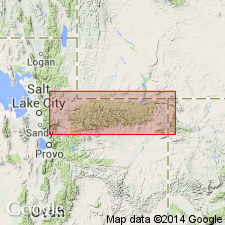
- Usage in publication:
-
- Durst group
- Modifications:
-
- Named
- Dominant lithology:
-
- Sandstone
- Shale
- Limestone
- AAPG geologic province:
-
- Wasatch uplift
- Uinta basin
- Uinta uplift
- Green River basin
Summary:
Named for Durst Mountain, a peak 7 mi north of Morgan, Morgan Co, UT on the Wasatch uplift. No type locality designated. Occurs from Rich Co, UT on the Wasatch uplift south and east along the flanks of the Uinta Mountains in Duchesne and Uintah Cos, UT in the Uinta basin, and on the north flank of the mountains in Daggett Co, UT on the Uinta uplift, into Moffat Co, CO in the Greater Green River basin. Divided into Hells Canyon (base), Morgan, and Weber (top) formations. Unconformably overlies Round Valley formation. Underlies Moenkopi formation. The three formations combined into a group because 1) they are shelf deposits that contrast to Oquirrh formation of the Oquirrh basin, 2) fauna are scarce and it is difficult to determine if a hiatus is present, 3) thicknesses of formations is not uniform, 4) contacts are gradational, 5) red color of Morgan is replaced by gray of the Weber. [Lithologies used for keywords are those that compose the three formations.] Considered to be Pennsylvanian age, Des Moines and younger. Correlation chart. Cross section.
Source: GNU records (USGS DDS-6; Denver GNULEX).
For more information, please contact Nancy Stamm, Geologic Names Committee Secretary.
Asterisk (*) indicates published by U.S. Geological Survey authors.
"No current usage" (†) implies that a name has been abandoned or has fallen into disuse. Former usage and, if known, replacement name given in parentheses ( ).
Slash (/) indicates name conflicts with nomenclatural guidelines (CSN, 1933; ACSN, 1961, 1970; NACSN, 1983, 2005, 2021). May be explained within brackets ([ ]).

